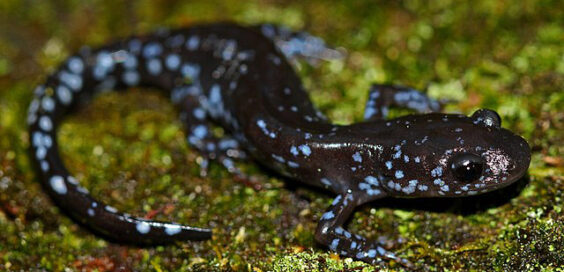
Creature Feature – Scurrying into Spring
Posted by Dustin Horton // April 1, 2025 // Articles, Creature Feature
Early spring finds various amphibians on the move. It’s an active time of year, especially around vernal pools and wetlands. These habitats support ecological communities rich in diversity, as many salamanders and frogs use them for breeding.
Take, for example, the blue-spotted salamander, which as an adult is terrestrial and only returns to the water to reproduce. It’s about 4-5 inches long with a dark blue or black body spattered with bluish-white spots. A nocturnal denizen of mixed forests and swamps, the blue-spotted salamander spends most of its life on the forest floor hunting for insects, spiders, worms, and snails, or resting in underground nooks. It emerges from its hibernation burrow in sync with mild, rainy nights when air temperatures are above 40 degrees. And so begins a timeless spring migration to ephemeral pools and wetlands within the woodlands.
Spring peepers will also be out in force, calling in a love sick cacophony so very iconic to early spring. It amazes me how these tiny frogs can produce such BIG sound! Loud mouths aside, it’s challenging to locate one of these wee crooners. Some frog fanatics use the “triangulation” method where 2-3 people point their flashlights to where they think a single peeper might be calling and then begin carefully searching where two or more beams intersect. Sounds like a fun spring activity to try with the kids!
Article by Margie Manthey
Photo from Wikimedia Commons / 2nd Peter













